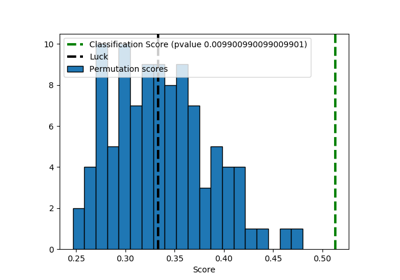sklearn.model_selection.permutation_test_score¶
-
sklearn.model_selection.permutation_test_score(estimator, X, y, groups=None, cv='warn', n_permutations=100, n_jobs=None, random_state=0, verbose=0, scoring=None)[source]¶ Evaluate the significance of a cross-validated score with permutations
Read more in the User Guide.
Parameters: - estimator : estimator object implementing ‘fit’
The object to use to fit the data.
- X : array-like of shape at least 2D
The data to fit.
- y : array-like
The target variable to try to predict in the case of supervised learning.
- groups : array-like, with shape (n_samples,), optional
Labels to constrain permutation within groups, i.e.
yvalues are permuted among samples with the same group identifier. When not specified,yvalues are permuted among all samples.When a grouped cross-validator is used, the group labels are also passed on to the
splitmethod of the cross-validator. The cross-validator uses them for grouping the samples while splitting the dataset into train/test set.- scoring : string, callable or None, optional, default: None
A single string (see The scoring parameter: defining model evaluation rules) or a callable (see Defining your scoring strategy from metric functions) to evaluate the predictions on the test set.
If None the estimator’s default scorer, if available, is used.
- cv : int, cross-validation generator or an iterable, optional
Determines the cross-validation splitting strategy. Possible inputs for cv are:
- None, to use the default 3-fold cross validation,
- integer, to specify the number of folds in a (Stratified)KFold,
- CV splitter,
- An iterable yielding (train, test) splits as arrays of indices.
For integer/None inputs, if the estimator is a classifier and
yis either binary or multiclass,StratifiedKFoldis used. In all other cases,KFoldis used.Refer User Guide for the various cross-validation strategies that can be used here.
Changed in version 0.20:
cvdefault value if None will change from 3-fold to 5-fold in v0.22.- n_permutations : integer, optional
Number of times to permute
y.- n_jobs : int or None, optional (default=None)
The number of CPUs to use to do the computation.
Nonemeans 1 unless in ajoblib.parallel_backendcontext.-1means using all processors. See Glossary for more details.- random_state : int, RandomState instance or None, optional (default=0)
If int, random_state is the seed used by the random number generator; If RandomState instance, random_state is the random number generator; If None, the random number generator is the RandomState instance used by np.random.
- verbose : integer, optional
The verbosity level.
Returns: - score : float
The true score without permuting targets.
- permutation_scores : array, shape (n_permutations,)
The scores obtained for each permutations.
- pvalue : float
The p-value, which approximates the probability that the score would be obtained by chance. This is calculated as:
(C + 1) / (n_permutations + 1)
Where C is the number of permutations whose score >= the true score.
The best possible p-value is 1/(n_permutations + 1), the worst is 1.0.
Notes
This function implements Test 1 in:
Ojala and Garriga. Permutation Tests for Studying Classifier Performance. The Journal of Machine Learning Research (2010) vol. 11


